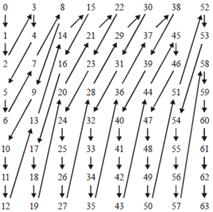宏块在经过变换、量化后,得到大小为4x4或者8x8的矩阵,矩阵中的数据被称为transform coefficient levels。这些level在后面会被用于熵编码,因此我们需要把矩阵按照一定顺序进行扫描,得到数字序列。
扫描顺序在帧与场会有所不同
4x4块矩阵的扫描顺序如下
Zig-zag scan(Frame) Field scan
8x8块矩阵的扫描顺序如下
Zig-zag scan(Frame) Field scan
在实际的代码处理上(JM),对变换系数的扫描过程是包含在量化过程中的,因为对矩阵内的元素的量化也是逐个进行的,因此就可以按照对变换系数扫描的顺序取出矩阵内的元素进行量化,后续就能直接对这些transform coefficient level序列进行熵编码。
int quant_4x4_normal(Macroblock *currMB, int **tblock, struct quant_methods *q_method)
{
VideoParameters *p_Vid = currMB->p_Vid;
QuantParameters *p_Quant = p_Vid->p_Quant;
Slice *currSlice = currMB->p_Slice;
Boolean is_cavlc = (Boolean) (currSlice->symbol_mode == CAVLC);
int block_x = q_method->block_x;
int qp = q_method->qp;
int* ACL = &q_method->ACLevel[0];
int* ACR = &q_method->ACRun[0];
LevelQuantParams **q_params_4x4 = q_method->q_params;
const byte (*pos_scan)[2] = q_method->pos_scan;
const byte *c_cost = q_method->c_cost;
int *coeff_cost = q_method->coeff_cost;
LevelQuantParams *q_params = NULL;
int i,j, coeff_ctr;
int *m7;
int scaled_coeff;
int level, run = 0;
int nonzero = FALSE;
int qp_per = p_Quant->qp_per_matrix[qp];
int q_bits = Q_BITS + qp_per;
const byte *p_scan = &pos_scan[0][0];
// Quantization
// 4x4 block matrix has 16 coefficients
for (coeff_ctr = 0; coeff_ctr < 16; ++coeff_ctr)
{
//scanning positions (Zig-zag scan or Field scan)
i = *p_scan++; // horizontal position
j = *p_scan++; // vertical position
//block_x,block_y here is the position of a block on a Macroblock with the unit of pixel
m7 = &tblock[j][block_x + i];
if (*m7 != 0)
{
q_params = &q_params_4x4[j][i];
scaled_coeff = iabs (*m7) * q_params->ScaleComp;
level = (scaled_coeff + q_params->OffsetComp) >> q_bits;
if (level != 0)
{
if (is_cavlc)
level = imin(level, CAVLC_LEVEL_LIMIT);
*coeff_cost += (level > 1) ? MAX_VALUE : c_cost[run];
level = isignab(level, *m7);
*m7 = rshift_rnd_sf(((level * q_params->InvScaleComp) << qp_per), 4);
// inverse scale can be alternative performed as follows to ensure 16bit
// arithmetic is satisfied.
// *m7 = (qp_per<4) ? rshift_rnd_sf((level*q_params->InvScaleComp),4-qp_per) : (level*q_params->InvScaleComp)<<(qp_per-4);
*ACL++ = level;
*ACR++ = run;
// reset zero level counter
run = 0;
nonzero = TRUE;
}
else
{
*m7 = 0;
++run;
}
}
else
{
++run;
}
}
*ACL = 0;
return nonzero;
}



